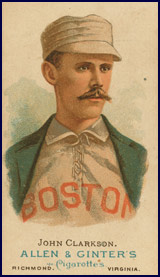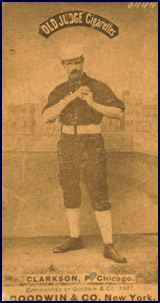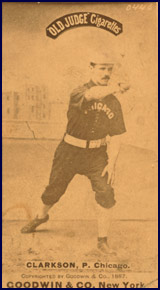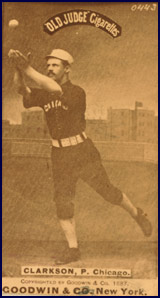John Clarkson
1861–1909
By Eric Miklich

lthough JOHN CLARKSON only pitched for 12 seasons, he complied statistics that would compare to a modern day pitcher with a twenty-three-year career. He won 328 games and lost only 178, finishing his career with a 2.81 Earned Run Average. He would pitch through three distance changes, two pitching delivery changes and two starting position changes. When he retired in 1894 he was the winningest pitcher in National League history.
John Gibson Clarkson debuted May 2, 1882, with the Worchester Ruby Legs. He would return to the National League with the Chicago White Stockings in 1884, and play four seasons for the club. In 1885, his first year as a regular, he would have one of two remarkable seasons. He led the league in wins with 53 (second most in NL history); innings pitched with 623 and strikeouts with 308 and helped the White Stockings to the pennant. Chicago and the St. Louis Browns of the American Association would end the season playing to a 3–3–1 “World Series” tie. On July 27, he pitched the only no-hitter of his career with a 4-0 win over the Providence Grays.
The two teams met again in the season ending 1886 championship series. With the Browns leading 3–2 in the best-of-seven series, Clarkson started his fourth game in six days. He held a 3–0 lead, but in the bottom of the eighth inning the Browns tied the game. Browns centerfielder Curt Welch singled to lead off the bottom of the tenth. It was only the fourth hit off Clarkson that day. Welch moved to third base on an infield hit and was sacrificed to third. Welch along with third base coach Arlie Latham, who was also a player, proceeded to distract Clarkson by heckling him and Welch made feigns as if hew was going to steal home. A Clarkson pitch got away from him and catcher “King” Kelly and Welch raced home with the series-winning run. It would be the only time the American Association would win the championship.
Clarkson was sold to the Boston Beaneaters for $10,000 in 1887. The previous year Boston had paid $10,000 for Chicago batting champion "King" Kelly. In 1889, Clarkson had perhaps the most dominant season by a pitcher in baseball history. He led the league in wins with 49, 11 more than the second place finisher. He pitched 620 innings which was 200 innings more than the runner-up. He completed 68 games, 22 more than the next pitcher and had eight shutouts, 4 more than runner-up. He would also lead the league in strikeouts, earned run average, lowest on-base percentage and winning percentage. He became only the fourth pitcher to win what is now considered the pitcher’s Triple Crown, the leader in wins, ERA and strikeouts. Even with Clarkson’s monumental accomplishments and with Charles “Old Hoss” Radbourn as their second pitcher who also won 20 games, the Beaneaters fell one game short of the pennant.
When the National League absorbed four American Association teams in 1891 it was decided that the 1892 season would be a “split” season. The wining team of the first half would meet the winning team of the second half for the championship series. After 16 starts and a 8–6 record with Boston, Clarkson was traded to the Cleveland Spiders and joined a pitching staff that included Cy Young. After finishing fourth in the first half of the season, Cleveland would win the second half and meet Boston in the season ending series. Boston would win the series 5–0–1.
Beginning in 1893, the pitching distance from home was increased for the third time in Clarkson’s career, to 60 feet 6 inches. Perhaps due to the numerous amount of innings he had pitched over the years, Clarkson had problems adjusting Although he did manage to pitch 295 innings and win 16 games that season, his batters-walked to batters-struck-out ratio, and number of hits allowed had increased significantly. In 1894, he would appear in only 22 games.
In twelve seasons Clarkson would pitch 4536.1 innings. He would pitch over 600 innings in a season twice and average 378 innings pitched per year. Of the 518 games he started he managed to finish all except 33 games. He also hit 24 home runs.
Armed with a variety of curveballs delivered from different arm angles and an uncanny ability to locate a hitter's weakness, Clarkson was a finesse pitcher who relied on his wits, rather than a blazing fastball. Tragically, it was his mind that eventually betrayed him. In 1906, while living in retirement in Michigan, Clarkson suffered a breakdown, was declared insane, and spent much of the remainder of his life in mental hospitals. He died in 1909 at the age of 47 from complications stemming from pneumonia.
Arguably, the greatest pitcher of the 19th century, Total Baseball ranks Clarkson as the fourth best pitcher of all time behind Hall of Famers Cy Young, Christy Matthewson and Lefty Grove. His 328 wins rank him 10th in baseball history, an amazing feat when one considers that his career lasted only 12 seasons.
In 1963, fifty-four years after his death in February of 1909, the Veteran’s Committee elected John Clarkson to the Baseball Hall of Fame.






